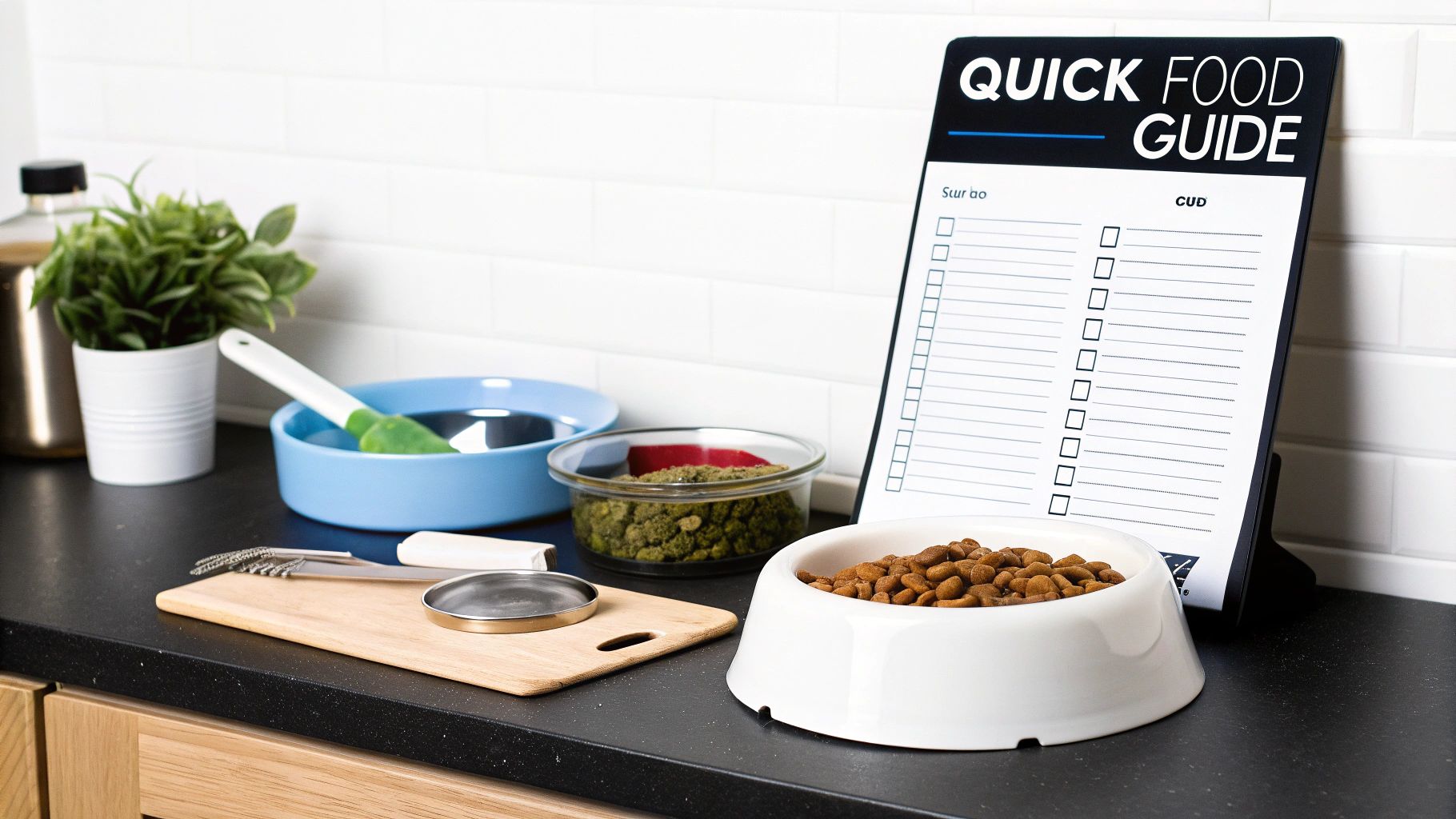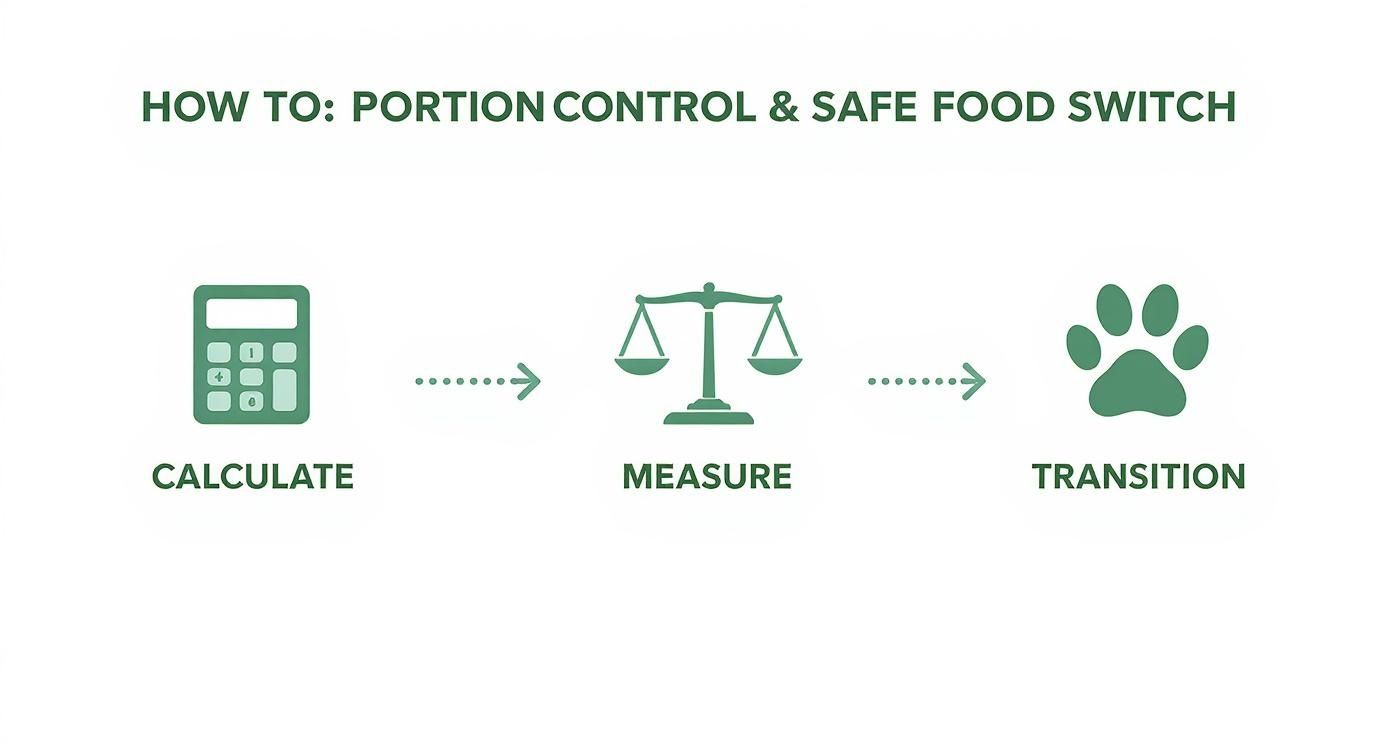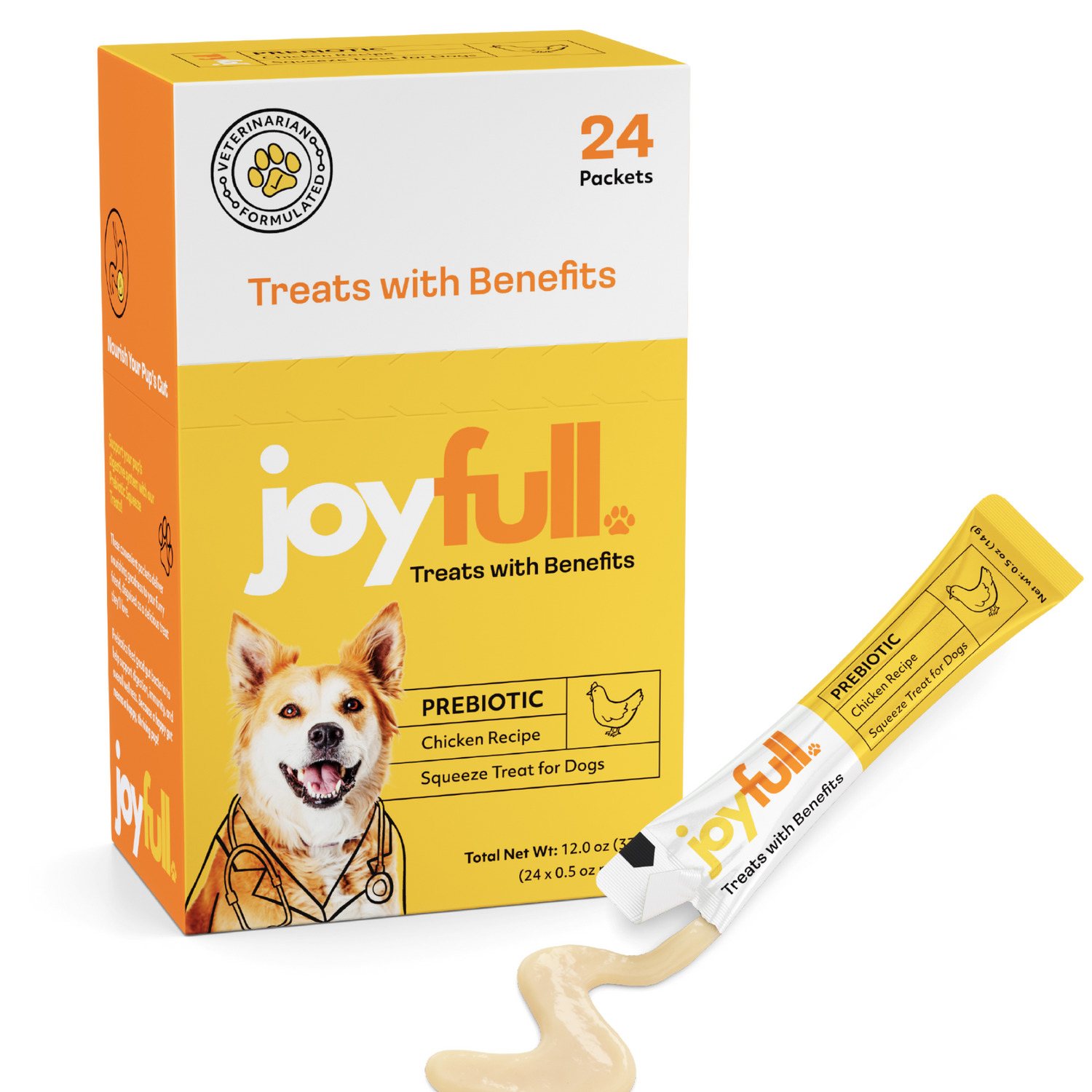
Choosing The Right Dog Food Without Guesswork
Feeding your dog well starts with matching its food to age, activity and any health quirks. Focus on clear, whole-food ingredients and a slow, sensible switch from old kibble to new.

By 2024, the global dog population climbed to 604.5 million—that’s a lot of hungry mouths relying on the right balance of nutrients. For a deeper look at these trends, see this dog food market report.
Essential Factors For Choosing The Right Dog Food
Start here before you shop: these checkpoints will steer you toward a formula that truly fits your dog.
-
Life Stage
Puppies, adults and seniors all need different nutrient ratios. Pick formulas designed for your dog’s current growth or maintenance phase. -
Breed Traits
A sprightly Border Collie burns far more calories than a couch-loving Bulldog. Match kibble to size and energy levels. -
Health Conditions
Dogs with allergies, sensitive stomachs or joint issues often thrive on limited-ingredient or specialty recipes. -
Ingredient Quality
Look for named proteins (chicken, lamb) and recognizable whole foods. Avoid vague “meat by-products” or fillers like corn. -
Portion Control
Use charts based on weight and activity to measure servings. Preventing weight gain is easier than reversing it. -
Transition Plan
Blend the old and new food over at least 7 days to keep tummies happy and digestion smooth.
Snapshot: Essential Factors Comparison
Use this table as a quick reference to see which considerations matter most for your pup.
Essential Factors Comparison
| Factor | Importance | Example |
|---|---|---|
| Life Stage | High | Puppy formula for lean growth |
| Breed Traits | Medium | Large-breed kibble with joint support |
| Health Conditions | High | Limited-ingredient for allergies |
| Ingredient Quality | High | Real chicken, no fillers |
| Portion Control | Medium | Activity-based feeding guide |
| Transition Plan | Low | 7-day gradual mix |
This snapshot helps you zero in on what’s critical—so you can dive deeper into each topic with confidence.
Key Takeaway: Your dog’s needs aren’t one-size-fits-all. Prioritize life stage, ingredient quality and any special health factors first.
Expert Insights And Tips
• When testing a new brand, offer it after a walk—dogs tend to feel hungrier and more open to change.
• Freeze treats made from the new kibble to gauge excitement levels before a full switch.
• Keep a feeding journal for a week when you start a formula; note energy, stool quality and appetite.
Happy feeding ahead! With these steps you’ll have a clear roadmap to nutritious, balanced meals your dog will love.
Assessing Your Dog’s Needs
Every dog brings a unique set of needs to the bowl. Age, activity level and health history all influence which formula works best. Skipping this step turns mealtime into guesswork.
Evaluating Life Stage
Puppies are little dynamos, burning calories fast and needing extra protein and DHA for brain and bone development. Adult dogs do best on balanced meals—about 25–30% protein-to-fat—to maintain lean muscle and steady energy. Seniors often appreciate lower-calorie recipes fortified with glucosamine, chondroitin and antioxidants to keep joints comfortable.
- Puppies: High-protein diets with DHA for brain and bone growth
- Adults: Balanced nutrition with a 25–30% protein-to-fat ratio
- Seniors: Calorie-controlled mixes enriched with glucosamine, chondroitin and antioxidants
Considering Breed Traits
Breed size and energy output dramatically shift calorie requirements. A high-octane Labrador might thrive on 450 kcal per cup formulations, while a more laid-back Bulldog fares better on lower-fat blends. Mid-size dogs like Beagles fall somewhere in between, needing moderate energy levels.
Matching kibble to your dog’s breed prevents obesity and promotes vitality.
Checking Joint Support Needs
Large breeds and older pups often battle joint stiffness and arthritis. Look for foods that guarantee around 200 mg of glucosamine per serving. Omega-3 fatty acids also play a starring role in reducing inflammation and protecting cartilage.
- Glucosamine: Supports cartilage repair and reduces discomfort
- Chondroitin: Helps retain joint fluid and absorb shocks
- Omega-3: Calms inflammation and boosts mobility
Many top-tier formulas weave these nutrients into every bowl, though supplements can bridge any gaps.
Identifying Food Sensitivities
If your dog is scratching relentlessly, battling ear infections or struggling with loose stools, an ingredient may be the culprit. Pay attention to common triggers:
- Itching: Often a reaction to specific proteins or fillers
- Digestive upset: Loose stools signal poor ingredient tolerance
- Coat troubles: Dry fur or hot spots can hint at missing nutrients
Check out our guide on navigating a sensitive stomach in dogs for targeted strategies and recipe ideas. Read also our sensitive stomach dog guide.
Gut health plays a critical role in your pet’s wellness. For a comprehensive understanding, explore this complete guide to dog gut health.
By 2024 the global dog population reached roughly 604.5 million, outnumbering cats by nearly 50% and highlighting how widespread commercial diets have become. Discover more insights about these findings (https://www.renub.com/dog-food-market-p.php).
Customizing Portions And Feeding Frequency
Once you’ve mapped out your dog’s profile, calculate daily calories by weight and activity. Smaller breeds generally need 30–40 kcal per pound, while athletic dogs can surpass 50 kcal per pound.
- Weigh your kibble on a kitchen scale for accuracy
- Split meals into two or three servings to sustain energy
- Tweak amounts weekly based on body condition and activity shifts
| Weight Range | Daily Calories | Serving Size Example |
|---|---|---|
| 10–25 lbs | 300–600 kcal | ½–1 cup |
| 26–50 lbs | 700–1200 kcal | 1½–2 cups |
| 51+ lbs | 1300+ kcal | 2+ cups |
JoyFull formulas deliver clean ingredients and precise nutrition, making portion tweaks effortless.
Tracking Progress And Adjustments
Set aside a monthly check-in to gauge weight and coat quality. If your dog gains or loses more than 5% of body weight in thirty days, cut or boost portions by about 10%.
- Keep a simple log of feeding amounts, exercise and physical changes
Celebrate the wins—every healthy pound and glossy coat shows you’re on the right track.
Building Your Assessment Checklist
Before you hit “buy,” jot down these essentials to compare recipes side by side:
- Life Stage & Breed Size: Age, weight category and growth phase
- Activity Level & Metabolism: Daily exercise routines and intensity
- Medical History & Health Conditions: Allergies, joint issues or digestive concerns
- Feeding Goals & Preferences: Weight management, skin support or energy needs
A clear, written plan transforms choosing the right dog food from guesswork into a data-driven decision.
Now you’re ready to dive into label reading and ingredient evaluation.
Reading Dog Food Ingredients And Labels

A glance at the ingredient list can feel overwhelming. But once you break it down, each term starts to tell you something valuable about the food’s quality.
When you spot a named protein—like chicken or lamb—it means you’re looking at real meat instead of generic fillers.
- By-Products often hide organ or bone leftovers that boost protein cheaply.
- Named Meat Meals reveal the exact animal source and usually pack more protein.
- Added Vitamins and minerals show the brand has fortified the formula; still, it’s smart to look for natural sources first.
Ingredients appear in order of weight, so what’s listed first makes up the bulk of the recipe. JoyFull puts clean components and named proteins right up front.
For a deeper dive, check out our guide on reading dog food labels.
Once you learn the basics, you’ll spot gaps in nutrition or unwanted additives in no time.
Interpreting Guaranteed Analysis
The guaranteed analysis spells out the percentages of protein, fat and fiber.
A formula with around 25% protein supports muscle health in adult dogs.
- Check Crude Protein minimum to understand meat content.
- Review Crude Fat to match your dog’s energy needs without going overboard.
- Keep Crude Fiber under 5% for smoother digestion.
Moisture tells you how much water is in the kibble, and ash hints at the total mineral content. Comparing these numbers side by side helps you pick the right match.
Key Insight Always choose recipes that list real food ingredients first to support digestion and immune function.
JoyFull skips artificial preservatives like BHA, BHT or ethoxyquin, leaning on natural tocopherols instead.
Industry reports project the dog food and snacks market to hit USD 4.4 billion by 2035, driven by a surge in organic, grain-free and health-focused formulas. Learn more in the FMI report on dog food and snacks market.
Comparing Label Examples
Looking at two labels side by side can be eye-opening.
| Ingredient Type | What To Look For |
|---|---|
| Real Meat | Chicken listed first |
| Whole Grains | Brown rice or oats for steady fiber release |
| Minimal Additives | Tocopherols or other natural preservatives |
Notice how whole foods like peas, carrots and sweet potatoes often show up higher on the list when a brand prioritizes nutrition.
- Don’t be fooled by “grain-free” or “high-protein” buzzwords—they can hide added fats or sugars.
- USDA Organic seals are great, but always scan the ingredient list.
- AAFCO statements confirm a formula meets life-stage requirements.
Questions? Reach out to JoyFull for a breakdown of any label that leaves you scratching your head.
Prioritizing Transparency
A clear label reflects a brand’s promise to your dog’s health.
Ingredient origins and manufacturing details become vital if your pup has allergies or sensitivities.
- Compare ingredient order across different brands for consistency.
- Spot artificial preservatives near the end of the list.
- Favor formulas with full AAFCO statements matching your dog’s life stage.
- Look for disclosures on sourcing regions and ingredient provenance.
Case Study A Golden Retriever struggled with skin irritation until her owner switched to a formula listing only five simple ingredients. Her coat improved, and digestion normalized within weeks.
Next Steps
With these label-reading skills, you’ll confidently select a formula that fits your dog’s age, activity level and health goals.
Keep this guide handy on your next pet store visit.
Up next, we’ll break down how to compare diet types and brands side by side.
Comparing Diet Types And Brands
Finding the right dog food means balancing your pet’s needs with your daily routine. Dry kibble, wet cans, fresh-frozen meals and raw diets all differ in prep time, nutrient concentration and storage. Let’s break down how they stack up.
Diet Type Comparison
Below is a side-by-side look at each format’s main benefits and drawbacks.
Diet Type Comparison
| Diet Type | Pros | Cons | Example Brand |
|---|---|---|---|
| Dry Kibble | Long shelf life; easy storage | Higher carbs; potential fillers | Joyfull Original |
| Wet Canned Foods | High moisture; very palatable | Opens need refrigeration; shorter life | Joyfull Limited Wet |
| Fresh-Frozen | Nutrient-dense; minimal processing | Requires freezer space; thaw time | Joyfull Fresh Mix |
| Raw Diets | Ancestral feeding style; coat boost | Careful handling to avoid contamination | Joyfull Raw Boost |
Each option has trade-offs. Think about your kitchen setup, budget and how much hands-on prep you want.
Weekly Menus By Life Stage
A rotating menu can keep your dog excited and support digestion.
• Monday & Thursday: Dry kibble topped with a probiotic powder.
• Tuesday & Friday: Limited-ingredient wet food for sensitive tummies.
• Wednesday & Saturday: Fresh-frozen mix of chicken, beef and veggies.
• Sunday: Supervised raw meaty bones for dental health.
Adjust portion sizes based on age and activity. Puppies may need more frequent meals, while seniors often prefer smaller, softer servings.
Evaluating Nutrient Density
When you flip a bag or can, these labels matter most:
• Protein Percentage (look for 30–40% in dry foods).
• Fat Percentage (higher for active days).
• Moisture Content (wet foods often sit at 75–80%, kibble around 10%).
• Fiber Levels under 5% support smooth digestion.
Fresh-frozen and raw diets typically deliver more calories per ounce, so you feed smaller amounts to reach the same energy target.
Balancing Cost And Convenience
Price tags tell part of the story—cost per 100 kcal gives the full picture:
• Budget kibble: $0.80–$1.00 per 100 kcal.
• Premium dry formulas: $1.50–$2.00 per 100 kcal.
• Wet foods: $2.50–$3.50 per 100 kcal.
• Raw diets: $4.00–$5.00 per 100 kcal.
Dry kibble wins for grab-and-go. Raw and fresh-frozen need freezer space and extra prep time. Factor both dollars and minutes when you decide.
Practical Tips From Dog Owners
Real-life feedback cuts through the noise:
“Switching to a limited-ingredient wet diet cut my dog’s tummy issues in half within two weeks,” says Mara, a Labrador owner.
“I saved nearly five hours a month on meal prep after moving to Joyfull Original kibble,” adds Tom, whose Border Collie thrives on higher protein.
Try mixing formats seasonally. Always ease into new foods over a week, monitoring appetite, stool quality and energy. A simple journal or spreadsheet will show subtle trends you might otherwise miss.
The global dog food market is projected to grow from $39.61 billion to $42.59 billion by 2025, driven by health-focused pet parents and premium formulations. Learn more about these findings in this report.
Next, we’ll use these comparisons to calculate portions and plan a smooth transition between diets. Enjoy exploring new options!
Calculating Portions And Transitioning Foods Safely
When you know exactly how many calories your dog needs each day, you sidestep guesswork—and avoid underfeeding or overfeeding. A quick calculation using weight, age, activity level and metabolism keeps your pup in that sweet spot of healthy condition.
Weigh your dog on a home scale, then chart its shape against an A–E body condition guide. A weekly check-in helps you notice subtle gains or losses before they become challenges.
This infographic breaks down the portion-control process and shows how to blend old and new foods safely.
It boils the approach into three core actions—Calculate, Measure and Transition—so you can swap diets without a hitch.
Calculating Daily Calorie Needs
Start with a guideline of 30–40 kcal per pound for most breeds, bumping up to 50 kcal for highly active dogs. Multiply your dog’s weight by the right rate to set your daily calorie goal.
For instance, a 25-lb Beagle on moderate exercise lands at about 25 × 35 = 875 kcal each day. From here:
- Divide total kcal into meal slots (two meals would be roughly 437.5 kcal each).
- Weigh kibble on a kitchen scale within ±2 grams for consistency.
- Monitor weight monthly and tweak calories by 10% if you see more than 5% change.
Refining Portions With Body Condition Scoring
Every pup’s body is unique. Feel for ribs and look at the waistline once a week to match your dog’s shape against the chart. Ideally, ribs should be easy to feel under a light layer of fat—never popping out.
If your dog sits at a 4/9 on the scale, pull back on calories by 10%, then reassess in two weeks. Small tweaks prevent drastic swings in weight and keep your dog comfortable.
Tip: Weigh and score at the same time each day—many owners find before breakfast works best.
Two-Week Transition Plan
A sudden switch can upset delicate stomachs. Ease into the new formula with this mixing schedule:
- Days 1–3: 75% old, 25% new
- Days 4–7: 50% old, 50% new
- Days 8–10: 25% old, 75% new
- Days 11–14: 100% new
Sprinkle in a teaspoon of plain pumpkin or low-sodium broth if your dog turns up its nose at change. When you’re ready to fine-tune portions, try our handy dog food portion calculator tool.
Tracking Tolerance And Adjusting Portions
Keep an eye on appetite, energy and stool quality throughout the swap. If something feels off, slow down the mix.
- Soft stools two days in a row? Pause at your current ratio.
- Vomiting or food refusal? Hold steady until your dog’s back to normal.
- No hiccups and a wagging tail? Push ahead to the next blend.
Printable Feeding Chart And Real-Life Example
Jasmine used a simple log to track her Golden Retriever during a food switch. By adding a few extra calories on days packed with agility training, she kept her dog’s muscles lean and energy high.
| Date | Blend Ratio | kcal Fed | Activity Duration | Stool Quality |
|---|---|---|---|---|
| Day 1 | 75/25 | 875 | 30 min walk | Firm |
| Day 7 | 50/50 | 890 | 45 min run | Soft |
| Day 14 | 0/100 | 900 | 1 hr agility | Firm |
With this chart posted by the feeding area, you’ll never guess at portions again—everything’s documented and data-driven.
Tips For Picky And Sensitive Stomachs
Dogs with sensitive tummies often need extra care during transitions. Pause if you see discomfort and bring in digestive support.
- Start at 75% of new portions for two days.
- Mix in probiotics or gentle fiber supplements.
- Increase by 5–10% only when your dog shows no signs of upset.
Note: Some pups thrive on five or six mini meals instead of two large ones.
Mastering these steps gives you the confidence to pick the right food and keep your dog thriving. Don’t forget to print your feeding chart, stick it by the bowl, and count treats toward that daily calorie goal.
When To Consult Your Vet And Troubleshooting Issues
Watching for the right signs can protect your dog’s health before minor problems spiral. Loose stools, relentless itching or sudden weight swings call for more than a DIY fix. Here’s when you should dial up professional help:
- Chronic Diarrhea lasting over 48 Hours
- Excessive Itching or recurring skin inflammation
- Sudden Weight Loss or unexplained weight gain
- Frequent Vomiting beyond a single incident
- Lethargy Or Mood Changes alongside feeding issues
Understanding Veterinary Tests
When simple observations don’t cut it, vets rely on targeted diagnostics. A blood panel might expose anemia, imbalances or early organ stress. That clarity lets you tweak meals and add the right supplements.
- Skin prick or intradermal tests to pinpoint allergens
- Serum IgE assays for immune-response insights
- Complete blood count and chemistry to assess organ health
- Fecal exams to detect parasites or absorption troubles
Keep a log of every treat, supplement and meal. This timeline is invaluable during diagnosis.
Running Elimination Diets
Elimination diets are the gold standard for uncovering hidden triggers. You’ll feed a single-protein formula for 8–12 Weeks, measuring portions to the gram. If symptoms vanish, reintroduce old ingredients one at a time to confirm culprits.
This phased approach reduces guessing and keeps your dog comfortable. If you hit any roadblocks, it never hurts to consult a local veterinarian for expert support.
Reading Blood Work Reports
Lab results are like a roadmap for your dog’s nutrition. Low albumin or an off-kilter globulin ratio signals protein trouble. Elevated liver enzymes could point to fat intolerance.
- Total Protein for overall nutrition check
- Alkaline Phosphatase indicating metabolic stress
- Creatinine and BUN to monitor kidney function
- Electrolytes (sodium, potassium, chloride) for hydration status
Use these markers to fine-tune fat levels and supplement choices.
Quick Vet Visit Checklist
A well-prepared visit keeps things efficient. Bring along:
- Detailed Feeding History
- Sample Of Current Food
- Journal Of Symptoms With Dates
- List Of Treats And Supplements
- Specific Questions About Nutrition
Afterward, summarize the vet’s recommendations and set any follow-up plans.
Troubleshooting Common Feeding Challenges
Introducing new kibble or wet food often meets resistance. I’ve seen dogs turn their noses up at multiple brands—until a simple trick worked wonders.
- Aversion: Stir in plain yogurt or pumpkin
- Gas or Bloating: Offer smaller, more frequent meals
- Loose Stools: Add a dash of psyllium husk
- Slow Eater: Try a puzzle feeder to extend mealtime
Tip Warm wet food for 15 seconds. It unlocks aroma and whets the appetite.
Keep a close eye on reactions and adjust as needed.
Advanced Troubleshooting Strategies
If basic tactics and elimination diets fall short, a veterinary nutritionist can dive deeper. They might recommend hydrolyzed protein formulas, targeted supplements or advanced allergy panels. Collate your lab results, feeding logs and notes before the appointment. It streamlines the consultation and speeds up solutions.
Key Takeaway Partnering with your vet delivers a safe, personalized feeding plan.
Follow these guidelines to tackle feeding hiccups head-on and keep your pup thriving.
FAQ
What’s the real difference between grain-free and limited-ingredient diets? Grain-free recipes swap out staples like corn or rice for alternatives such as peas or potatoes. On the flip side, limited-ingredient options narrow down proteins and carbs to cut down on allergy triggers.
How often should you rotate formulas for optimal health? Most vets suggest cycling your dog’s meals every 4–6 weeks. That rhythm not only keeps your pup interested but also mixes up the amino acid profile and supports a diverse gut microbiome.
- Try rotating proteins (chicken, beef, fish) in a predictable rotation
- Pay attention to changes in stool or sudden shifts in appetite
- Ease into each new formula over about 7 days
Homemade Meals Versus Commercial Formulas
Can homemade meals fully replace commercial food? It’s possible, but you need a detailed plan. Without regular nutrient analysis you could miss 30% of vitamins and minerals your dog needs.
Homemade diets can work but require blood tests and weekly journaling to ensure nutrient adequacy
When should you watch for signs that your dog dislikes a formula? Look out for:
- Reluctance at mealtime or flat-out refusal
- Loose or overly firm stools lasting more than two days
- Excessive scratching or noticeable skin redness
- A weight swing beyond 5% in a single month
Spot any of these red flags? Pause the switch and dig into ingredient lists. Running lab tests or trying an elimination trial often uncovers the culprit.
Each answer gives you the confidence to make smart feeding decisions.
Ready to give your dog clean nutrition? Check out Joyfull at Joyfull

